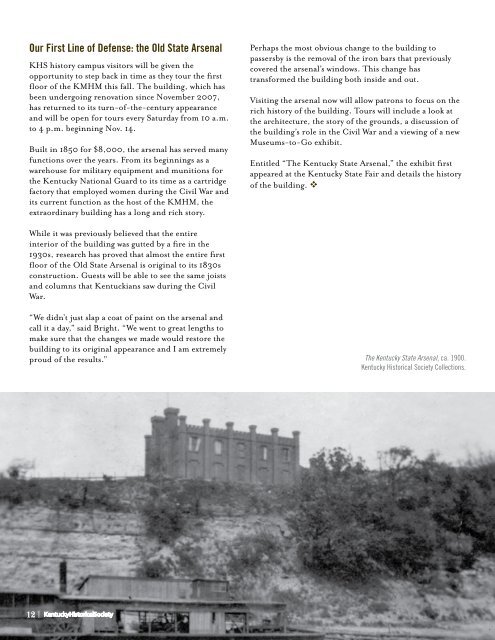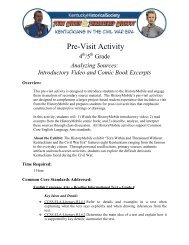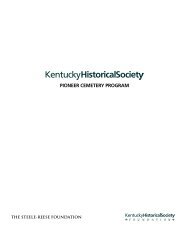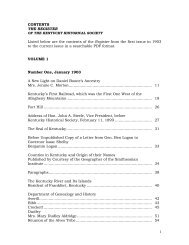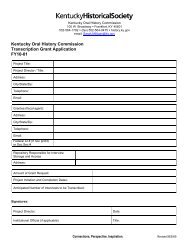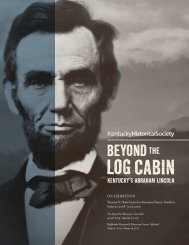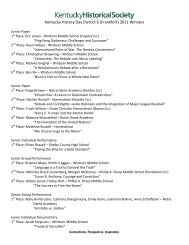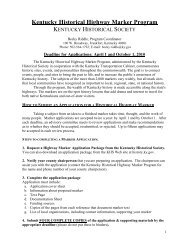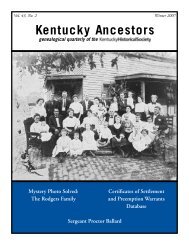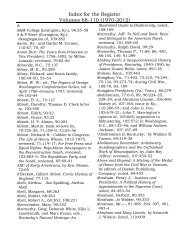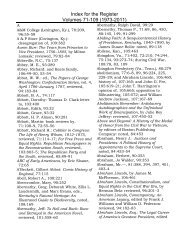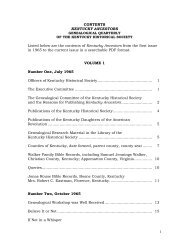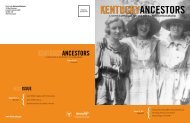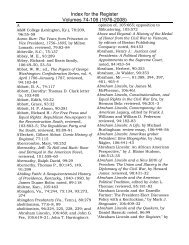Chronicle Fall 2009 - Kentucky Historical Society
Chronicle Fall 2009 - Kentucky Historical Society
Chronicle Fall 2009 - Kentucky Historical Society
You also want an ePaper? Increase the reach of your titles
YUMPU automatically turns print PDFs into web optimized ePapers that Google loves.
Our First Line of Defense: the Old State Arsenal<br />
KHS history campus visitors will be given the<br />
opportunity to step back in time as they tour the first<br />
floor of the KMHM this fall. The building, which has<br />
been undergoing renovation since November 2007,<br />
has returned to its turn-of-the-century appearance<br />
and will be open for tours every Saturday from 10 a.m.<br />
to 4 p.m. beginning Nov. 14.<br />
Built in 1850 for $8,000, the arsenal has served many<br />
functions over the years. From its beginnings as a<br />
warehouse for military equipment and munitions for<br />
the <strong>Kentucky</strong> National Guard to its time as a cartridge<br />
factory that employed women during the Civil War and<br />
its current function as the host of the KMHM, the<br />
extraordinary building has a long and rich story.<br />
While it was previously believed that the entire<br />
interior of the building was gutted by a fire in the<br />
1930s, research has proved that almost the entire first<br />
floor of the Old State Arsenal is original to its 1830s<br />
construction. Guests will be able to see the same joists<br />
and columns that Kentuckians saw during the Civil<br />
War.<br />
“We didn’t just slap a coat of paint on the arsenal and<br />
call it a day,” said Bright. “We went to great lengths to<br />
make sure that the changes we made would restore the<br />
building to its original appearance and I am extremely<br />
proud of the results.”<br />
12 |<br />
Perhaps the most obvious change to the building to<br />
passersby is the removal of the iron bars that previously<br />
covered the arsenal’s windows. This change has<br />
transformed the building both inside and out.<br />
Visiting the arsenal now will allow patrons to focus on the<br />
rich history of the building. Tours will include a look at<br />
the architecture, the story of the grounds, a discussion of<br />
the building’s role in the Civil War and a viewing of a new<br />
Museums-to-Go exhibit.<br />
Entitled “The <strong>Kentucky</strong> State Arsenal,” the exhibit first<br />
appeared at the <strong>Kentucky</strong> State Fair and details the history<br />
of the building. v<br />
The <strong>Kentucky</strong> State Arsenal, ca. 1900.<br />
<strong>Kentucky</strong> <strong>Historical</strong> <strong>Society</strong> Collections.<br />
A ‘CRAZY’ IDEA<br />
Family Heirloom Finds its Way to KHS<br />
Mother and daughter Lucile (left) and<br />
Lysbeth (right) Van Cleve Wallace.<br />
In 1975, Lucile Van Cleve Wallace decided to make<br />
a Christmas gift for her daughter, Lysbeth. Lucile’s<br />
“crazy idea” was to create a quilt for her daughter. She<br />
had recently seen a crazy quilt and thought this would<br />
be a good present. Crazy quilts were highly decorative<br />
objects for the home. Quilters used interesting<br />
materials, including brightly-colored fabrics and<br />
threads, to show off their artistic taste and embroidery<br />
skills. Names, initials and family-related pieces added<br />
a personal connection to the quilts. Though crazy<br />
quilts’ popularity peaked in the late 19th and early 20th<br />
century, the tradition never died.<br />
Lucile knew her daughter would appreciate the very<br />
idea of a crazy quilt. Lysbeth was an artist and designer<br />
who had studied at the University of <strong>Kentucky</strong>,<br />
the Institute of Design in Chicago and Cranbrook<br />
Academy, among others. She earned degrees in art,<br />
pottery and weaving. Her travels had taken her to<br />
the Philippines as part of a U.N.program to develop<br />
weaving and wood carving industries in that country.<br />
Lysbeth also taught at several colleges in Illinois and<br />
then at Western <strong>Kentucky</strong> University.<br />
For Lucile, this gift started as a simple “crazy [quilt]<br />
idea.” It was not intended to be a family history. But,<br />
as she explains in a Christmas card message to her<br />
daughter, it soon “became a historical and personal<br />
journey.” The cloth and thread became a document<br />
about the Wallace family and their life in western<br />
<strong>Kentucky</strong>. Piecing together bits of material and hiding<br />
the squares when Lysbeth visited, Lucile began to stitch<br />
together her idea. Throughout the year, she lovingly<br />
crafted this quilt.<br />
Some blocks referenced Lysbeth’s art or teaching<br />
career, while others told of her travels to the<br />
Philippines or Hong Kong. A “Big Apple” square<br />
represented a dance attended by Lysbeth during<br />
her college days. Some squares would remind her<br />
of important family places, the strawberries which<br />
grew on the farm of Lucile’s father or tobacco from<br />
www.history.ky.gov | 13


